Campfire cooking is a tradition that’s as much about creating memories as it is about crafting delicious meals. Picture this: a starlit evening, the soothing crackle of the fire, and the irresistible aroma of dinner cooking over an open flame. Campfire cooking isn’t just a way to fill your belly; it’s an experience that blends adventure with the timeless joy of preparing food in the great outdoors.
Today, we’re diving into “The Essential Campfire Cooking Equipment for Open Fire Gourmets.” Whether you’re a seasoned pro or a first-timer, choosing the right gear transforms campfire cooking from a chore into a seamless, enjoyable activity. With the right tools, you’ll not only impress your fellow campers with your culinary skills but also elevate your entire outdoor experience.
This isn’t just about flavor—it’s about safety, convenience, and the sheer satisfaction of crafting mouthwatering meals using nothing but fire and a few well-chosen tools. Whether you’re searing the perfect steak, simmering a hearty stew, or toasting marshmallows to perfection, having the right gear makes all the difference.
Campfire cooking embodies the spirit of outdoor luxury. It’s rustic yet refined, adventurous yet comforting. Don’t stress about perfection your first time out; focus on the essentials, embrace the process, and savor the flavors that only an open flame can provide.
Coming up next, we’ll talk about fuel, because every great chef knows that your heat source is as important as your ingredients. I’ll share tips on selecting the perfect type of wood to complement your cooking style and create the ideal environment for your campfire culinary adventure. So, grab your gear, ignite your passion, and let’s get cooking!
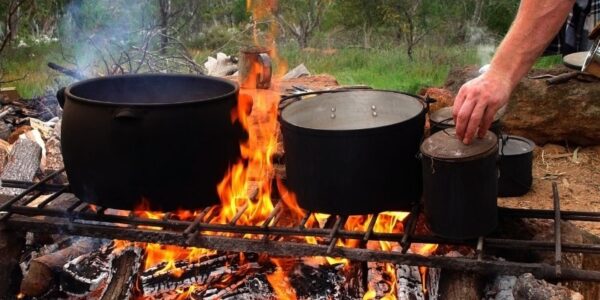
Choosing the Right Fuel
When it comes to luxury camping, the fuel you choose for your campfire isn’t just about keeping a flame alive; it’s about enhancing your entire outdoor culinary experience. The right firewood can influence the flavor, heat control, and overall success of your campfire cooking adventure. Let’s refine this fundamental step so your glamping experience is as seamless as it is gourmet.
Let’s Talk Firewood For consistent, long-lasting heat and minimal smoke, hardwoods like oak, hickory, and maple are the gold standard. These dense woods burn steadily, providing the ideal conditions for slow cooking or grilling, ensuring your steaks, veggies, and gourmet s’mores come out perfectly. On the other hand, softwoods like pine or cedar burn quickly and produce a lot of smoke, which can overpower the delicate flavors of your dishes. Keep those for starting your fire, but rely on hardwoods for the main event.
In keeping with sustainable camping practices, always source firewood locally to prevent the spread of invasive pests or diseases. This not only supports the environment but also ensures you’re abiding by Leave No Trace principles, which align perfectly with the ethos of luxury camping.
Considering Charcoal While hardwoods bring rustic authenticity, there’s no shame in turning to charcoal for precision and control. Charcoal burns evenly and consistently, making it perfect for dishes requiring specific cooking temperatures. It’s an excellent option for beginners or when you’re looking to prepare a gourmet meal without worrying about fluctuating heat levels. While you might sacrifice some of the rich, smoky aroma that wood provides, the reliability of charcoal can be a game-changer for luxury campers aiming for culinary perfection.
With a solid understanding of the fuel fundamentals, you’re one step closer to mastering the art of campfire cooking. Next, we’ll dive into the essential cooking gear that every outdoor chef needs. Trust me, having the right tools at your disposal can elevate your campfire dining from rustic to refined.
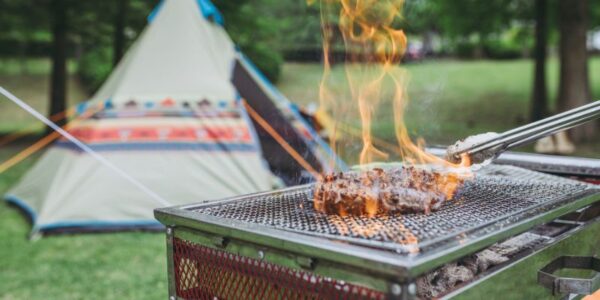
Essential Campfire Cooking Equipment
When it comes to luxury glamping, your campfire cooking setup should blend practicality with a touch of refinement. It’s not just about rugged durability—it’s about curating tools that enhance your culinary experience while making outdoor cooking feel effortless and enjoyable. Here’s a guide to the must-have equipment for your glamping kitchen.
1. Cast Iron Skillet:
A true classic, the cast iron skillet is a must for its versatility and even heat distribution. Whether you’re flipping golden pancakes or searing a thick, juicy steak, this workhorse handles it all. For added convenience, consider one with a pre-seasoned finish, and don’t forget a pair of stylish, heat-resistant gloves to handle those piping-hot handles.
2. Heavy-Duty Grill or Grate:
A solid, reliable grill grate elevates your glamping setup. Perfect for setting over an open flame, it’s ideal for holding pots or grilling food directly for that signature smoky char. Opt for a durable, heat-resistant design that’s as functional as it is sleek.
3. Dutch Oven with a Twist:
A Dutch oven isn’t just a cooking pot; it’s your ticket to gourmet campfire meals like hearty stews, slow-braised meats, or even freshly baked bread. Choose one with sturdy legs for easy placement over coals and a flanged lid that doubles as a coal holder for even heat distribution. It’s a staple that brings rustic charm to any luxury campsite.
4. Elegant Long-Handled Utensils:
Safety meets sophistication with long-handled tongs, spatulas, and ladles. These tools keep your hands safely away from the heat while adding a touch of class to your cooking process. For those who like precision, a campfire tripod with adjustable height can make a world of difference in heat control.
5. Portable Cutting Board and Chef’s Knife:
Don’t underestimate the power of proper prep. A durable yet lightweight cutting board and a sharp, ergonomic knife make ingredient prep a breeze, whether you’re slicing vegetables or carving a perfectly roasted chicken.
6. Compact, Luxury Accessories:
Consider adding a few thoughtful extras, like a collapsible sink for easy cleanup or a stylish spice organizer to elevate your meals. These small touches bring a sense of ease and luxury to your campfire kitchen.
Investing in high-quality cooking equipment not only makes your glamping experience more enjoyable but also helps you prepare memorable meals with confidence. It’s not about owning every gadget; it’s about choosing tools that reflect your style and elevate your outdoor culinary adventures.
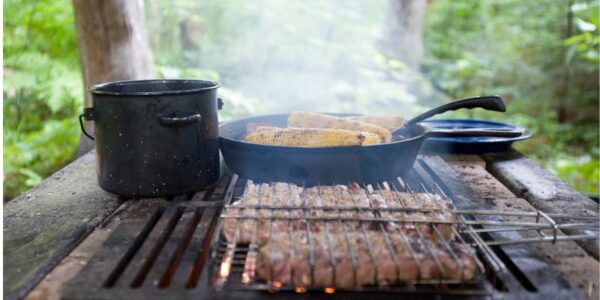
Mastering Cooking Techniques
Cooking over an open flame may seem like a primal art, but with the right techniques, it becomes a refined skill. For luxury campers, mastering these methods will elevate your campfire meals from rustic to gourmet. Let me share a few secrets for taming those flames to create unforgettable dishes.
There’s a fine balance between raw, untamed heat and the controlled precision needed for the perfect sear or simmer. With these tips, you’ll learn how to grill a steak to perfection, bring a pot of chili to a steady boil without it bubbling over, and infuse your ribs with just the right amount of smoky goodness.
1. Heat Zones – The Secret to Control:
Positioning your cooking gear is essential. Divide your fire into zones of heat—direct for high-intensity searing and indirect for slow, even cooking. For example, place your skillet close to the flames for a quick sear, then move it to the outer edges to let your dish finish cooking gently.
2. Smoking Made Simple:
For something like smoked fish, the key is distance. Hang or position your food far enough from the flames to let it bask in a gentle, aromatic smoke. This low-and-slow method adds depth and flavor that’s sure to impress your guests.
3. Ash as a Heat Barrier:
Here’s a pro tip: a thin layer of ash can act as a natural heat diffuser. Place wrapped items like baked potatoes or vegetables on a bed of ash to prevent them from overcooking while still maintaining a steady heat.
4. Timing and Rotation:
Cooking over a fire isn’t just about setting it and forgetting it. Rotate your food regularly to ensure even cooking and keep an eye on how the flames or embers change over time. Fire is dynamic, and adjusting to it is part of the charm.
Luxury camping is about more than just the meal—it’s about the process. Every campfire meal is an opportunity to refine your skills and embrace the adventure. Don’t worry about perfection; even seasoned outdoor chefs started with a few charred edges!
In the next section, ‘Leave No Trace: Responsible Campfire Shutdown and Cleanup,’ we’ll dive into the often overlooked but essential part of campfire cooking: the aftermath. Because true luxury isn’t just in the cooking—it’s in leaving the space pristine for the next adventurer.

Leave No Trace
One of the most important principles of outdoor luxury—and outdoor life in general—is to leave no trace. Preserving nature’s beauty ensures the next campers can enjoy it as much as you did. And when it comes to campfire cooking, a responsible cleanup is just as important as the feast itself. Here’s how to wrap things up in style while respecting the wilderness.
1. Burn It Down to Ash
Whenever possible, let the fire burn completely to ash. This isn’t just about neatness—it’s a crucial safety measure. Spread the coals around inside the fire pit to help them cool faster and prevent hot spots. Remember, never assume a fire will go out on its own.
2. Extinguish the Fire Properly
Water is your best friend here. Douse the fire thoroughly, making sure to soak all the embers, not just the glowing red ones. Listen for the hissing sound—that’s the reassuring noise of a properly extinguished fire. If water isn’t available, dirt can work, but be cautious: burying hot coals can cause smoldering and even reignition later on.
3. Confirm It’s Safe
Once you’ve cooled the fire, do the hand test. Hover your hand over the ashes to check for any residual heat. If you feel even the slightest warmth, keep cooling and stirring. Only when the ashes are completely cold should you scatter them in a wide area away from your campsite.
4. Clean Your Cooking Gear
Don’t leave food scraps or grease behind. Wipe down your pots, pans, and utensils thoroughly to avoid attracting wildlife. A simple wipe at the campsite is fine, but a deep clean back at home will ensure your gear stays in top condition for your next adventure.
5. Pack It All Up
Dry your equipment thoroughly before storing it to prevent rust and mildew—trust me, you don’t want to unpack a rusty skillet on your next trip. Take one last look around your campsite to make sure no trash, food, or gear has been left behind. Even small items like bottle caps or scraps of foil can detract from the pristine wilderness experience.
By following these steps, you’re not just cleaning up—you’re showing respect for the natural world and helping to preserve it for future campers. After all, true luxury camping isn’t just about comfort; it’s about leaving the great outdoors just as majestic as you found it.
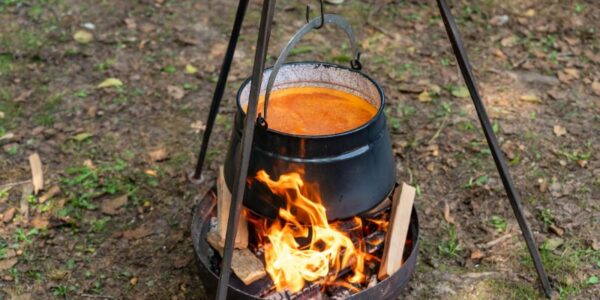
Wrapping Up the Campfire Chronicles
As we close this journey into the art of campfire cooking, let’s take a moment to reflect on what we’ve covered—from selecting the perfect fuel to mastering the flames, choosing the right equipment, and ensuring you leave no trace.
Cooking over an open fire is more than just a way to prepare a meal; it’s an experience that connects you with nature and tradition. It’s about creating something uniquely flavorful, with hints of smoke and adventure, that no conventional kitchen can replicate.
For luxury campers, this ancient cooking method is a way to elevate your outdoor escapades. It’s not just about the food; it’s about the ambiance of the crackling flames, the satisfaction of preparing something with your own two hands, and the stories you’ll share around the fire.
Don’t fret if your first attempt isn’t flawless. Campfire cooking is a craft meant to be enjoyed and improved upon with each outing. The beauty lies in the process—and in the memories you’ll create.
So, invest in equipment that feels right for your style and embrace the adventure of outdoor culinary creativity. Whether you’re searing a perfectly marbled steak or simmering a pot of gourmet stew under the stars, the possibilities are as boundless as the sky itself.
Now it’s your turn to light the fire, savor the flavors, and discover the joys of open-flame cooking. I’ll leave you with one question: What’s the first dish you’ll create on your next campfire cooking adventure? Let me know—I’d love to hear about your fiery culinary creations!

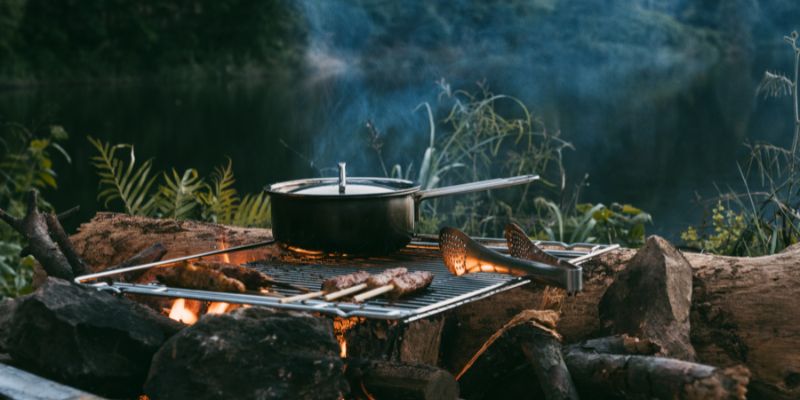
Leave a Reply